| dc.contributor.author | Dwyer, Róisín M. | |
| dc.contributor.author | Bergert, Elizabeth R. | |
| dc.contributor.author | O'Connor, Michael K. | |
| dc.contributor.author | Gendler, Sandra J. | |
| dc.contributor.author | Morris, John C. | |
| dc.date.accessioned | 2019-09-04T12:39:08Z | |
| dc.date.available | 2019-09-04T12:39:08Z | |
| dc.date.issued | 2006-06-15 | |
| dc.identifier.citation | Dwyer, Róisín M., Bergert, Elizabeth R., O'Connor, Michael K., Gendler, Sandra J., & Morris, John C. (2006). Adenovirus-Mediated and Targeted Expression of the Sodium–Iodide Symporter Permits In Vivo Radioiodide Imaging and Therapy of Pancreatic Tumors. Human Gene Therapy, 17(6), 661-668. doi: 10.1089/hum.2006.17.661 | en_IE |
| dc.identifier.issn | 1557-7422 | |
| dc.identifier.uri | http://hdl.handle.net/10379/15389 | |
| dc.description.abstract | Pancreatic cancer is the fourth leading cause of cancer death in the United States. It is highly aggressive with no uniformly effective chemotherapy available for metastatic disease. The sodium–iodide symporter (NIS) is a transmembrane protein responsible for uptake of iodide into cells. The presence of NIS in thyroid cells permits diagnostic imaging and therapy of thyroid tumors, using radioiodide. Previous studies from this laboratory reported mucin-1 (MUC1)-driven expression of NIS in cancer cells. MUC1 overexpression has also been reported in 90% of pancreatic tumors. In this study Ad5/MUC1/NIS was used to infect pancreatic cancer cells both in vitro and in vivo, to investigate the potential for radioiodide imaging and ablation of this disease. In vitro studies revealed a 43-fold increase in iodide uptake in NIS-transduced cells compared with controls. In vivo imaging revealed effective iodide uptake and retention at the site of NIS-transduced tumors, with optimal uptake (13% of injected dose) observed 5 hr after iodide administration. Intravenous delivery was performed to investigate potential hepatotoxicity of the construct in the event of virus leakage. Intravenous injection of Ad5/CMV/NIS resulted in robust iodide uptake throughout mouse liver, whereas no uptake was detected in the liver of animals given Ad5/MUC1/NIS intravenously. Administration of therapeutic doses of 131I resulted in significant regression of NIS-transduced tumors, with a mean 50% reduction in volume within 10 weeks of therapy (p < 0.0001). The ability to target NIS expression to pancreatic cancer, which has such limited treatment options, may be highly beneficial and warrants further investigation. | en_IE |
| dc.description.sponsorship | Funding for this work was received from the Prospect Creek
Foundation, a Mayo Foundation Prostate Cancer SPORE grant
(CA91956), the Mayo Breast Cancer Program, and the Molecular Medicine Program of the Mayo Clinic College of Medicine. | en_IE |
| dc.format | application/pdf | en_IE |
| dc.language.iso | en | en_IE |
| dc.publisher | Mary Ann Liebert | en_IE |
| dc.relation.ispartof | Human Gene Therapy | en |
| dc.rights | Attribution-NonCommercial-NoDerivs 3.0 Ireland | |
| dc.rights.uri | https://creativecommons.org/licenses/by-nc-nd/3.0/ie/ | |
| dc.subject | NIS | en_IE |
| dc.subject | MUC1 | en_IE |
| dc.subject | radioiodide | en_IE |
| dc.subject | gene therapy | en_IE |
| dc.subject | pancreatic cancer | en_IE |
| dc.title | Adenovirus-mediated and targeted expression of the sodium-iodide symporter permits in vivo radioiodide imaging and therapy of pancreatic tumors | en_IE |
| dc.date.updated | 2019-08-16T10:22:16Z | |
| dc.identifier.doi | 10.1089/hum.2006.17.661 | |
| dc.local.publishedsource | https://doi.org/10.1089/hum.2006.17.661 | en_IE |
| dc.description.peer-reviewed | peer-reviewed | |
| dc.internal.rssid | 1167634 | |
| dc.local.contact | Róisín Dwyer, Surgery, Nui Galway. 3008 Email: roisin.dwyer@nuigalway.ie | |
| dc.local.copyrightchecked | Yes | |
| dc.local.version | ACCEPTED | |
| nui.item.downloads | 361 | |


